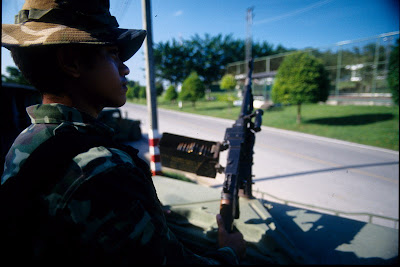
“states attempt, physically and discursively, to marginalize or destroy various aspects of centrifugal otherness: ethnic solidarities, reasserted nationalisms, indigenous movements, and draft resistances, all dissonant elements proclaiming the tenuous hold of states over territories and identities”
Thailand is not a nation-state yet it pretends to be. In a complex process of ethnic competition and state formation a myth has been nurtured that Thailand is built around a nation of ‘Thais’.Such an idea is utter non-sense. By adopting the Westphalian model of a nation-state, Thailand has conformed to the logic of the international system at the expense of ethnic diversity within its borders.To become a nation-state the dominant state sanctioned identity, the Thais, have had to internally colonize their territory by subjugating minority identities to create and perpetuate not only the political state but the very definition of Thai identity.
The process of Thailand’s self-colonization has striking similarities to the theoretical foundations of Europe’s colonial adventures. As Siamese (Thai) identity was transforming under pressure from the arrival of Europeans it was placed in comparison to the state’s own subaltern identities.
Siamese comparisons followed the intellectual fault identified by Palestinian academic Edward Said in his seminal work;
Orientalism.The failings of Thai
orientalism stem from classifying and applying stereotyped roles for minorities as ‘primitive’ and ‘traditional’ – mirroring the same sense of superiority that Europeans used to rationalize their colonial presence.
Like the colonial powers were doing across SEA, the Siamese began an orientalist study of the ethnic minorities that the state's modern borders contained.
The Siamese classified them, detailed their customs, their dress, their beliefs, and opened museums to display the ‘others’ within their borders.
By interpreting the state’s minorities as ‘primitive’ and ‘traditional’ the state cast itself in a rationally paternalistic roll whose dominance over minorities was implicit.
The unique utility of orientalism is the way that the classification of ‘others’ does more to identify the ‘self’ (in this case the Siamese) than that of the ‘other’ (the minorities). If the ethnic minorities were ‘primitive’ and ‘traditional’ then the Siamese would be ‘advanced’ and ‘modern’. As a tool of nationalist state-craft it is essential to have an ‘other’ as there is simply no nation if it can not be compared to an apposing minority or alternate nation. The minorities within Thailand’s borders serve a necessary function of being the ‘other’ to Thailand’s ‘self’. By studying and classifying the state’s minorities as oppositional ‘others’ the Thai state has been able to define who the ‘Thai’ are and what the ‘Thai state’ represents.
Non-state identities being ‘others’ within the Thai state act as a threat to the state’s identity while paradoxically giving the state legitimacy by allowing the state to express its own existence.
The ‘otherness’ of minorities is closely associated to alternate nations and, particularly if viewed through the global
Westphalian system of nation-states, their presence within the state represents a violation of state order that must be either assimilated into the defined nation-state identity or be controlled by the state’s legitimate right to use force.
By disciplining the ‘others’ within their territory, the nation-state exercises its existence and its identity brought to life.
As the modern Thai state has adopted the
Westphalian model it has conformed to the logic of the international system at the expense of the country’s minorities.
Thailand has colonized itself into the international system and has/is attempted/
ing to internally colonize the non-state identities within its borders.
Essentially, the very definition of Thai identity has been articulated because it is in contrast to the minorities and the state's presence is brought to life by exercising authority over the country’s minorities.



